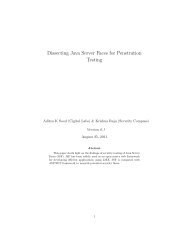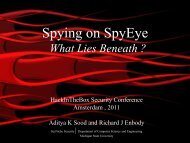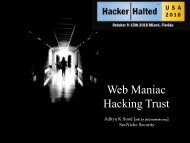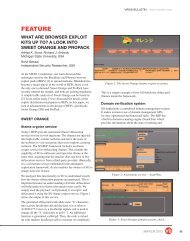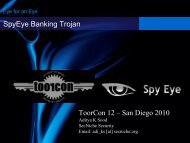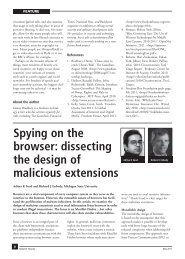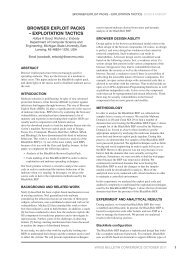Bonded with Botnets. - SecNiche Security Labs
Bonded with Botnets. - SecNiche Security Labs
Bonded with Botnets. - SecNiche Security Labs
You also want an ePaper? Increase the reach of your titles
YUMPU automatically turns print PDFs into web optimized ePapers that Google loves.
<strong>Bonded</strong> <strong>with</strong> <strong>Botnets</strong><br />
Hard to Capture the Beast<br />
US-CERT GFIRST, Atlanta, August 2012<br />
Aditya K Sood | Richard J Enbody<br />
<strong>SecNiche</strong> <strong>Security</strong> | Department of Computer Science and Engineering<br />
Michigan State University
About Us<br />
• Aditya K Sood<br />
● PhD Candidate at Michigan State University<br />
– Worked for Armorize, COSEINC, KPMG and others as contractor.<br />
– Active Speaker at <strong>Security</strong> conferences<br />
» DEFCON, RSA, SANS, HackInTheBox, OWASP AppSec, BruCon and others<br />
– LinkedIn - http ://www.linkedin.com/in/adityaks<br />
– Website: http://www.secniche.org | Blog: http://secniche.blogspot.com<br />
– Twitter: @AdityaKSood<br />
• Dr. Richard J Enbody<br />
● Associate Professor, CSE, Michigan State University<br />
– Since 1987, teaching computer architecture/ computer security<br />
– Co-Author CS1 Python book, The Practice of Computing using Python.<br />
– Patents Pending – Hardware Buffer Overflow Protection<br />
2
Agenda<br />
• Overview<br />
• Present-day bot infection tactics<br />
• Subverting Client-side systems integrity<br />
• Conclusion<br />
3
Disclaimer<br />
The opinions and views expressed in this presentation are<br />
completely based on our independent research and do not relate to<br />
any of our previous or present employers.<br />
4
Generations of <strong>Botnets</strong><br />
• First Generation<br />
─ Internet Relay Chat (IRC) Protocol<br />
• Second Generation<br />
─ Peer-to-Peer (P2P) Protocol<br />
• Third Generation<br />
─ Hyper Text Transfer Protocol (HTTP)<br />
• Hybrid<br />
─ Mix of characteristics of different generations of botnets<br />
5
Browser Malware Taxonomy<br />
Class-A<br />
Class-B<br />
Class-C<br />
6
Malware Paradigm<br />
7
Browser Exploit Packs (BEPs)<br />
• Browser Exploit Pack<br />
─ BlackHole is running on fire<br />
● Techniques<br />
– User-agent based fingerprinting<br />
– Plugin detector capability for scrutinizing the plugins<br />
– Serving exploit once per IP Address<br />
– Java exploits are used heavily for spreading infections<br />
– Support for other exploits such as PDF, Flash etc<br />
Refer, our previous research on BlackHole presented at Virus Bulletin Conference, 2011<br />
• http://www.secniche.org/papers/VB_2011_BRW_EXP_PACKS_AKS_RJE.pdf<br />
• http://www.slideshare.net/adityaks/virus-bulletin-2011-conference-browser-exploitpacks-death-by-bundled-exploits<br />
8
Obfuscated Iframes – Present-day<br />
• Obfuscated pattern<br />
─ Taken during analysis of AT&T Phishing Campaign<br />
9
Obfuscated Iframes – Present-day<br />
• De-obfuscated pattern<br />
─ Output<br />
─ More details on analysis<br />
● http://secniche.blogspot.com/2012/04/javascript-obfuscation-manual-armor-1.html<br />
● http://secniche.blogspot.com/2012/04/javascript-obfuscation-manual-armor-2.html<br />
10
BlackHole BEP<br />
•<br />
11
Phoenix BEP<br />
12
Redkit BEP<br />
13
Demo<br />
14
Drive-by-Download Attacks<br />
• Drive-by-Download<br />
● Victim browser is forced to visit infected website<br />
● Iframe redirects browser to the BEP<br />
● Exploit is served by fingerprinting the browser environment<br />
● Browser is exploited successfully<br />
● BEP silently downloads the malware onto the victim machine<br />
15
Drive-by Frameworks<br />
16
Drive-by Frameworks<br />
17
Demo<br />
18
Install-by-Install (IBI)<br />
• Install-by-Install<br />
● Concept- Installing malicious executables on the already infected systems<br />
● Different from Pay-per Install (PPI) programs<br />
– PPI works effectively <strong>with</strong> Browser Exploit Packs<br />
– It is a kind of fresh installation of bots on the non-infected systems<br />
● IBI and PPI are the different sides of the same coin<br />
● Sold as different services in the underground market<br />
● IBI is used in the crimeware services such as bot shops, task execution, etc.<br />
19
Task Execution - Install-by-Install (IBI)<br />
• Install-by-Install<br />
● Concept- Installing malicious executables on the already infected systems<br />
● Different from Pay-per Install (PPI) programs<br />
– PPI works effectively <strong>with</strong> Browser Exploit Packs<br />
– It is a kind of fresh installation of bots on the non-infected systems<br />
● IBI and PPI are the different sides of the same coin<br />
● Sold as different services in the underground market<br />
● IBI is used in the crimeware services such as bot shops<br />
20
• Malvertisement<br />
Malvertisements<br />
● Online malicious advertisements<br />
● Content Delivery Networks (CDNs) are infected to trigger malvertising<br />
– Distributed attack<br />
More on the malvertisement, refer to following post and paper:<br />
Armorize’s Blog - http://blog.armorize.com/2011/05/porn-sites-have-lots-of-trafficand.html<br />
Malvertisement Paper - http://www.slideshare.net/adityaks/malvertising-exploiting-web-advertising<br />
21
Infecting Web Hosting Servers<br />
• Data Centers | Web Hosting - Exploitation<br />
─ Several websites are hosted on a single server sharing IP address<br />
– DNS names are mapped virtually to the same IP<br />
● Vulnerability in one website can seriously compromise the server<br />
– Insecure file uploading functionality<br />
» Uploading remote management shells such c99 etc<br />
» Automated iframe injector embeds malicious iframe on all webpages<br />
» Making configuration changes such as redirecting users to malicious domains<br />
– Cookie replay attacks in hosting domain website<br />
» Authentication bypass : reading customer queries on the web based management<br />
panel<br />
» Extracting credentials directly by exploiting design flaws in hosting panels<br />
22
• Social Networks<br />
Exploiting Social Networks<br />
● Attackers exploit the inherent design flaws in the social networks<br />
● Use to spread malware at a large scale<br />
─ LikeJacking (=~ClickJacking)<br />
● Use to add malicious links on user’s profile in Facebook<br />
● LikeJacking collaboratively used <strong>with</strong> ClickJacking<br />
● Efficient in spreading malware<br />
23
Demo<br />
24
Tactics – Subverting System’s Integrity<br />
25
Understanding Ruskill<br />
• What is Ruskill ?<br />
─ A termed coined in Russia<br />
● It refers to the group of warriors who demonstrate their skill in the battle<br />
● Typically used by Diablo game players to demonstrate the strength and power<br />
─ How does Ruskill is related to bots?<br />
● Ruskill module is used to demonstrate the capability of bots<br />
● Removing traces of malware in the system after successful reboot<br />
26
Understanding Ruskill<br />
• Inside Ruskill Module<br />
─ Found in the NGR (Dorkbot)<br />
─ Remote file downloading and execution<br />
● Ruskill allows the bot to fetch any executable from third-party resource and<br />
execute it in the compromised system<br />
─ Restoring System<br />
● Ruskill monitors all the changes performed by the malicious executable in the<br />
system<br />
● Ruskill restores the registry, files ad network settings to the same state ( before<br />
the execution of malicious binary) after reboot<br />
● Deletes the malicious executable after successful execution in the system<br />
27
Demo<br />
28
• DNS Changer<br />
─ How this works?<br />
● Replacing the DNS server entries in the infected machine <strong>with</strong> IP addresses of<br />
the malicious DNS server<br />
● Adding rogue entries in the hosts configuration file<br />
● Executing DNS amplification attack by subverting the integrity of LAN<br />
devices such as routers and gateways<br />
– It results in DNS hijacking at a large scale in the network<br />
● Hooking DNS libraries<br />
DNS Changer<br />
– The preferred method is Inline hooking in which detour and trampoline functions<br />
are created to play <strong>with</strong> DNS specific DLLs.<br />
29
• DNS Changer<br />
─ Inside DNS hooking<br />
● Hooking DNS API<br />
DNS Changer<br />
– Hooking DNSQuery (*) function calls in dnsapi.lib/dnsapi.dll<br />
– Implemented by creating a blacklist<br />
– Bot hijacks the DNS resolution flow by filtering all the incoming DNS requests<br />
● Hooking DNS Cache Resolver Service<br />
– Cache resolver service is used for DNS caching<br />
– Bot hooks sendto function in ws2_32.dll to verify the origin of DNS query to<br />
validate if sendto function is called by dnsrsslvr.dll<br />
30
Demo<br />
31
Downgrading Browser <strong>Security</strong><br />
• Removing Protections<br />
─ Nullifying browser client side security to perform stealthy operations<br />
─ Internet Explorer<br />
● Tampering zone values in the registry<br />
─ Firefox<br />
– \Software\Microsoft\Windows\CurrentVersion\Internet Settings\Zones<br />
● Manipulating entries in user.js file<br />
– user_pref("security.warn_submit_insecure",false);<br />
» Browser does not raise an alert box when information in sent over HTTP while<br />
submitting forms<br />
– user_pref("security.warn_viewing_mixed",false);<br />
» Remove the warning of supporting mixed content over SSL<br />
OLD School trick but works very effectively. Several other techniques<br />
of subverting the browser security also exists.<br />
32
• Inside MitB<br />
Man-in-the-Browser (MitB)<br />
─ MitB typically refers to a userland rootkit that exploits the browser<br />
integrity<br />
33
Chase Notification Alert !<br />
Note: The Pop up is triggered in user’s<br />
active session. So what it is actually?<br />
No doubt it is a Popup, but the<br />
technique is termed as Web Injects not<br />
phishing or something like that.<br />
34
• Web Injects<br />
Web Injects<br />
─ Based on the concept of hooking specific functions in the browser DLLs<br />
─ On the fly infection tactic<br />
─ Execution flow<br />
● Bot injects malicious content in the incoming HTTP responses<br />
● Injections are based on the static file named as webinjects.txt<br />
● Rules are statically defined by the botmaster<br />
● Bot fetches rules from the webinjects.txt file and injects in the live webpages<br />
─ Information stealing in a forceful manner<br />
● Exploits user ignorance<br />
35
Web Injects<br />
• What is meant by GPH flags?<br />
─ Exploitation and infection metrics<br />
● G - injection will be made only for the resources that are requested by the GET<br />
● P - injection will be made only for the resources that are requested by the<br />
POST<br />
● L - is a flag for grabbing content between the tags data_before and data_after<br />
inclusive<br />
● H – similar as L except the ripped content is not included and the contents of<br />
tags data_before and data_after<br />
36
Web Injects – Real Time Cases (1)<br />
Forceful Cookie Injection in<br />
Citibank’s website to<br />
manipulate the user’s session<br />
37
Web Injects – Real Time Cases (2)<br />
Injecting HTML content in Bank of<br />
America’s webpages to steal the<br />
ATM number and the Pass code.<br />
Injecting HTML content in Wells<br />
Fargo bank to steal user’s ATM<br />
code.<br />
38
• Form Grabbing<br />
Form-grabbing<br />
─ It is an advanced technique of capturing information present in forms<br />
39
• Why Form Grabbing ?<br />
Form-grabbing<br />
─ Keylogging produces plethora of data<br />
─ Form grabbing – extracting data from the GET/POST requests<br />
─ Based on the concept of hooking<br />
─ No real protection against malware<br />
40
Form-grabbing<br />
• Harvested Data<br />
Harvested data from POST<br />
requests. Kaspersky’s anti virus<br />
license key entered by the user<br />
41
Demo<br />
42
Conclusion<br />
• Continuous war of existence.<br />
• Law of Asymmetry rules in the world of botnets.<br />
43
Questions !<br />
44
Thanks<br />
• US-CERT GFIRST Team<br />
● http://www.us-cert.gov/GFIRST/<br />
• <strong>SecNiche</strong> <strong>Security</strong> <strong>Labs</strong><br />
● http://www.secniche.org<br />
● http://secniche.blogspot.com<br />
• Contact Me<br />
─ Email : adi_ks [at] secniche.org<br />
45



